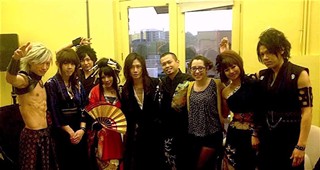Kaci and the Wagakkiband: A SXSW Interview
Rock + traditional Japanese instruments = 俊英!
By Kaci Beeler and Wayne Alan Brenner, 1:05PM, Wed. Mar. 23, 2016
Before those well-dressed forces of nature that comprise Wagakkiband rocked the adoring crowd at SXSW's Des Moines Embassy last week, Chronicle freelancer (and sometimes cover model) Kaci Beeler stopped by the Zella House lounge to find out what all the buzz was about.
Abetted by the fine linguistic skills of affable translator and media rep Kaz Hayashida, our correspondent's conversation with the group of nascent superstars revealed much of interest and delight …
[The eight-member band: Yūko Suzuhana (lead vocals), Machiya (guitar, backing vocals), Beni Ninagawa (tsugaru shamisen), Kiyoshi Ibukro (koto), Asa (bass), Daisuke Kaminaga (shakuhachi), Wasabi (drums), and Kurona (wadaiko).]
Kaci: It’s an honor to meet you in person – I’m excited to do this interview, and I have a bunch of questions. So, what does Wagakki mean?
Yuko: Wagakki means Japanese traditional instruments – like shakuhachi, shamisen, koto, and the traditional drums.
Kaci: And what is it about these traditional instruments that attract musicians like yourselves?
Yuko: Some of us, our parents are big traditional instrumentalists, so when we were children, we grew up close to the Wagakki traditions. And, in playing, we wanted to take these instruments outside of Japan.
Kaci: So taking the traditional instruments throughout Japan and outside of that? And that’s happening now – just three years after you started. So it’s like your third birthday.
Yuko: Yes!
Kaci: Happy birthday!
[laughter]
Kaci: Have you noticed an impact as you’ve been doing this work? Has there been an upswing in the number of people – younger people, especially – interested in the traditional instruments, because of you being who you are and getting more popular?
Yuko: We get a whole bunch of feedback, especially from Facebook and YouTube, and, yes. Even those kids whose parents aren’t remotely associated with Wagakki, they become familiar with the traditions. And we feel it’s our mission to popularize the traditional instruments.
Kaci: Your music sounds like it blends a lot of styles and genres. And I’m curious, since we’re in Texas, in the U.S. – are there any American bands that have influenced Wagakkiband?
Yuko: Each of us has a different artist, different musicians who they like. But as a band, as a unit, we don’t have a specific one.
Kaci: Okay, then can each person tell me some of their favorite bands?
Wasabi: Metallica, Red Hot Chili Peppers. And Merzbow.
Asa: Good Charlotte, Marilyn Manson.
Kiyoshi: Bon Jovi, Marilyn Manson, Red Hot Chili Peppers.
Yuko: Piano was my major in college, and I like Keith Jarrett. And, as a singer, Mariah Carey.
Machiya: Extreme. And Slipknot. And American Head Charge.
Daisuke: I also, besides shakuhachi, play piano. So – Billy Joel. And Guns ’n Roses. Mr. Big.
Yuko: Me, too – Billy Joel!
Beni: Lady Gaga, Madonna.
Kurona: Kiss, Motley Crüe, and Red Hot Chili Peppers.
Kaci: That’s a lot of different influences. It must be great to have eight people collaborating in one band. What are the advantages of having that many minds and voices involved in one project?
Yuko: When we arrange a song from eight different directions, it becomes so diverse – like three-dimensional.
Kaci: Is there anybody who’s specifically leading the band, or is it more of an ensemble effort?
Asa: Most of us also write, so whoever writes the song, that person becomes the leader of that piece.
Kaci: Ah, that makes a lot of sense – it’s like improv. And, uh, I want to talk about Vocaloid. Because I feel like Western audiences don’t know much about it. I know that, the first time I was aware of it, I was like, “What is this? What is this trend?” But Wagakkiband got a lot of recognition, early on, through Vocaloid. So can you say what Vocaloids are – and explain their popularity in Japan?
Asa: Vocaloid is a vocal synthesizer, and a few years ago there was a specific product that became very famous: Hatsune Miku.
Kaci: With the blue hair.
Asa: Yes, and that came from samples from cartoon voice actors. And not only professional, but the amateurs used it to create songs – and they would upload their songs to social media sites, like the Japanese version of YouTube. And it became a huge trend. And, after that, other artists, other bands covered famous Vocaloid songs – and that became an even bigger movement. And that’s when Wagakkiband took a similar approach, to cover a Vocaloid song in their way, using traditional instruments, and upload it to social sites. And they did, and it exploded.
Kaci: That was your first huge hit. And what inspired you to do that, to cover a Vocaloid song in traditional style?
Yuko: When Vocaloid started, that was the cutting-edge technology, kind of representing modern Japan. And at the same time, when we got together, we were concentrating on the traditional ways. And we wanted to make a link between traditional music and extremely modern music.
Asa: And some Vocaloid songs have an element of traditional Japanese music in them – in the songwriting aspects.
Kaci: So you took something that was already there and pushed it even further. Using real instruments and real voices, you made those Vocaloid songs really come alive in a way that maybe they don’t in the synthetic format?
Yuko: And another reason we wanted to cover a Vocaloid song is because traditional instruments are so forgotten among the younger generations. But all the kids and teenagers are going crazy about Vocaloid. So, in order to promote the traditional style, that’s the link that makes sense. We put that together intentionally.
Kaci: It seems like, just three years, you’ve had a pretty quick rise to popularity. What’s that been like? Did it catch you by surprise?
Wasabi: Yes.
[laughter]
Kaci: And your studio album just came out in February?
Yuko: It came out in September in Japan, but the U.S. release – and on Spotify – was in February.
Kaci: What was the easiest part of recording together? And what was the hardest?
Machiya: The hard part is that it takes time, because there are eight of us. But that’s also the easy part – because there are eight of us, each giving unique ideas, so good things can materialize quickly. So it could be very quick, but it could also be hard and time-consuming – it could take much longer. But that process makes the band and the song become better. In fact, we’ve started to write songs for our next album, and we just had a ten-day camp, a retreat, for us to write the songs.
Kaci: Like everyone was locked in a room for ten days?
[laughter]
Yuko: And we worked so fast and hard – and the songs, we feel, have gotten better and better.
Kaci: So when’s the next album coming out?
Yuko: Once we have a lot more songs, and we decide on a theme for the next album, then we’ll choose which songs to include.
Kaci: Ah, you want a wide pool to grab from. So no sharp deadline right now?
Yuko: Yes, that’s the process.
Kaci: You just did a show in the U.S., in New York. Are there differences between Japanese and American audiences?
Yuko: We played Los Angeles last summer, too. And there’s more of a difference between L.A. and New York audiences. Because, Japanese audiences, they seem to enjoy a live concert more as a group – and that’s like a New York audience. With a Los Angeles audience, it seems more like individuals enjoying the experience.
Kaci: And, okay, one last question – where do you see yourselves five years from now?
Yuko: Older.
[laughter]
Yuko: Actually, five years from now – even just four years from now – there’s a Tokyo Olympics. So we see ourselves as representing Japan there, representing the old-world traditions.
And in case you still haven't seen that amazing video:
A note to readers: Bold and uncensored, The Austin Chronicle has been Austin’s independent news source for over 40 years, expressing the community’s political and environmental concerns and supporting its active cultural scene. Now more than ever, we need your support to continue supplying Austin with independent, free press. If real news is important to you, please consider making a donation of $5, $10 or whatever you can afford, to help keep our journalism on stands.
Sept. 3, 2021
March 22, 2024
March 22, 2024
Wagakkiband, Kaci Beeler, J-pop in Austin, SXSW2016, Des Moines Embassy, Zella House











